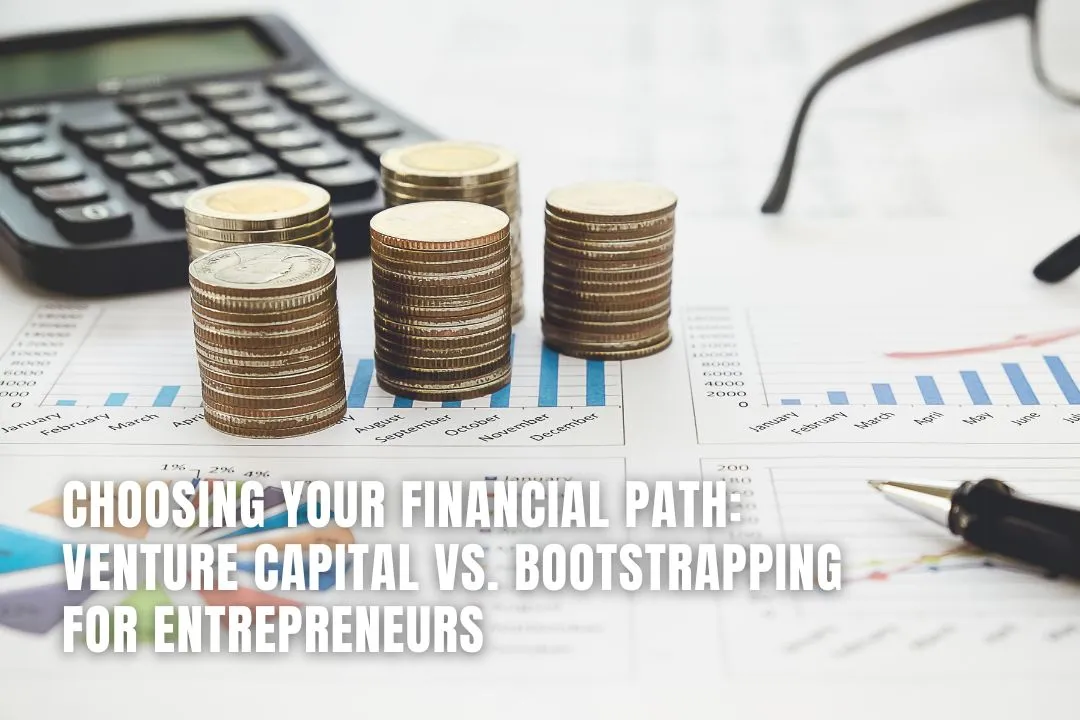Choosing Your Financial Path: Venture Capital vs. Bootstrapping for Entrepreneurs
November 7, 2024

Starting a new business can be thrilling, but it also comes with tough choices. One of the most important decisions for entrepreneurs is how to fund their startup. They can either bootstrap, which means using their own money and resources, or seek venture capital (VC), which involves raising money from outside investors in exchange for a share of the company. Each option has its benefits and drawbacks, and understanding them is key to making the right choice for your business.
Key Takeaways on Venture Capital and Bootstrapping
- Bootstrapping vs. Venture Capital: The main difference lies in the funding source. Bootstrapping uses personal savings or business profits, while venture capital involves raising money from external investors in exchange for equity.
- Venture Capital Promotes Rapid Growth: Venture capital provides startups with significant funding, enabling fast expansion, increased marketing, and talent acquisition.
- Bootstrapping Ensures Full Control: Entrepreneurs who bootstrap retain complete control over their business decisions and avoid external pressures or ownership dilution.
- Venture Capital Involves Equity Dilution: One downside of venture capital is the loss of ownership and decision-making power, as investors take a stake in the company.
- Bootstrapping Builds Financial Discipline: Entrepreneurs who bootstrap often develop a strong sense of financial discipline, finding cost-effective solutions to grow their business.
- Industry and Market Conditions Matter: The decision to pursue venture capital or bootstrap largely depends on the market demand, competition, and industry conditions.
- Exit Strategies Are Affected by Funding Choices: The funding path chosen can influence exit options, with venture-backed startups more likely to aim for an IPO, while bootstrapped businesses may consider strategic acquisitions or organic growth.
Register Your LLC
Company Registration
START NOWUnderstanding the Basics of Venture Capital and Bootstrapping

Starting a business can be exciting, but it also comes with tough choices. One of the biggest decisions entrepreneurs face is how to fund their startup. Venture capital and bootstrapping are two main ways to do this.
Defining Venture Capital
Venture capital (VC) is when a startup gets money from outside investors, like venture capital firms. In return, these investors get a share of the company. This funding helps startups grow quickly by providing them with a lot of cash and resources.
Defining Bootstrapping
Bootstrapping means starting and growing a business using the founder's own money and resources. This can include personal savings and profits from the business itself. Bootstrapping allows entrepreneurs to keep control of their company and make decisions without outside influence. It often requires being resourceful and finding creative ways to succeed, especially when funds are tight. As one source puts it, bootstrapping allows you to maintain control and scale your company on your own terms.
Key Differences Between the Two
Here’s a quick comparison of venture capital and bootstrapping:
Understanding these two funding methods is crucial for entrepreneurs. Each path has its own benefits and challenges, and the right choice depends on the startup's goals and values.
Choosing between venture capital and bootstrapping can shape the future of your startup. It's important to weigh the pros and cons carefully before making a decision.
Advantages and Disadvantages of Venture Capital
Access to Significant Capital
One of the main benefits of venture capital is the ability to access large amounts of money. This funding can help startups grow quickly. Here are some key points:
- Accelerated growth: With more money, startups can invest in marketing, hire skilled workers, and expand into new areas.
- Expert guidance: Venture capitalists often have experience and connections that can help startups succeed.
- Increased credibility: Having well-known investors can make a startup more attractive to customers and partners.
Dilution of Equity
While venture capital can provide a lot of resources, it also means giving up some ownership of the company. This can lead to:
- Loss of control: Founders may have to share decision-making with investors.
- Pressure to perform: Investors expect high returns, which can push startups to focus on short-term gains instead of long-term goals.
- Ownership dilution: Each time a startup raises money, the founders own a smaller piece of the company.
Impact on Decision-Making
Venture capital can influence how a startup is run. Some effects include:
- Shared authority: Founders may need to consult with investors on major decisions.
- Focus on exit strategies: Investors often want a quick return, which can lead to pressure for an IPO or sale.
- Potential conflicts: Differences in vision between founders and investors can create challenges.
Venture capital can be a double-edged sword; it offers growth opportunities but can also lead to loss of control and pressure to perform.
Advantages and Disadvantages of Bootstrapping
Maintaining Control and Ownership
Bootstrapping allows entrepreneurs to keep full control over their business. This means they can make decisions without needing to consult outside investors. Here are some benefits of maintaining control:
- Freedom to Experiment: Founders can try new ideas without needing approval.
- Long-Term Focus: They can prioritize sustainable growth instead of short-term profits.
- Retaining Equity: Founders keep all the ownership, which can lead to greater future profits.
Financial Discipline and Independence
When entrepreneurs bootstrap, they often become more disciplined with their finances. They learn to manage their money wisely and focus on profitability from the start. This financial independence can be empowering. Here are some key points:
- Resourcefulness: Startups learn to do more with less, finding creative solutions to problems.
- Lean Operations: They prioritize essential expenses, fostering a culture of efficiency.
- Self-Sufficiency: Relying on personal savings or early revenue helps build a strong foundation.
Challenges of Limited Resources
While bootstrapping has its perks, it also comes with challenges. Here are some difficulties faced by bootstrapped startups:
- Limited Growth: Without external funding, scaling can be slow.
- Resource Constraints: They may struggle to hire top talent or invest in marketing.
- Increased Risk: Using personal savings can add pressure to make the business profitable quickly.
Bootstrapping can be a rewarding journey, but it requires careful planning and a willingness to adapt. Entrepreneurs must be ready to face challenges head-on while enjoying the benefits of independence and control.
Summary
In summary, bootstrapping offers significant advantages like control and financial discipline, but it also presents challenges such as limited resources and slower growth. Entrepreneurs must weigh these factors carefully when deciding on their financial path.
Factors to Consider When Choosing Between Venture Capital and Bootstrapping
Startup Goals and Values
When deciding between venture capital and bootstrapping, it's crucial to assess your startup's goals and values. Here are some key points to consider:
- Long-term vision: Determine if your focus is on rapid growth or sustainable profitability.
- Control: Think about whether you want to maintain full ownership or are okay with sharing it.
- Risk tolerance: Evaluate how much risk you are willing to take on.
Industry and Market Conditions
The industry and market can greatly influence your funding choice. Consider the following:
- Market demand: Is there a strong demand for your product or service?
- Competition: How competitive is your industry?
- Funding trends: Are investors actively looking for opportunities in your sector?
Risk Tolerance and Growth Aspirations
Your personal risk tolerance and growth aspirations are vital in this decision. Reflect on these aspects:
- Willingness to take risks: Are you comfortable with the uncertainties of bootstrapping?
- Growth speed: Do you want to grow quickly or at a steady pace?
- Financial stability: Can you manage with limited resources, or do you need significant capital?
Choosing the right funding path is essential for your startup's success. Understanding your goals and the market landscape will help you make an informed decision.
Real-World Examples of Successful Startups
Bootstrapped Success Stories
Many entrepreneurs have shown that it is possible to build a thriving business without outside funding. MailChimp is a great example; it started as a side project and grew by focusing on customer value. Other notable bootstrapped companies include:
- Basecamp
- GitHub
- Atlassian
These companies often prioritize profitability and sustainable growth, using their limited resources wisely. They focus on cash flow, keeping costs low, and retaining customers. This approach allows them to adapt quickly to market changes.
VC-Backed Success Stories
On the other hand, venture capital has propelled many startups to rapid success. Companies like WhatsApp, Groupon, and Snapchat have benefited from significant funding, allowing them to scale quickly. These companies often have unique products that can grow fast with the right investment.
Lessons Learned from Both Approaches
Both bootstrapping and venture capital have their pros and cons. Here are some key takeaways:
- Bootstrapping can lead to greater control and ownership.
- Venture capital can provide the necessary funds for rapid growth.
- Understanding your market and product uniqueness is crucial in deciding which path to take.
In the end, the choice between bootstrapping and venture capital depends on your business goals and the market conditions. Each path has its own set of challenges and rewards, and learning from the experiences of others can guide your decision.
Exit Strategies and Their Alignment with Funding Choices
The choice between bootstrapping and venture capital (VC) funding can greatly influence the exit strategies available to startups. Understanding these strategies is crucial for entrepreneurs.
IPO as an Exit Strategy
- VC-funded companies often aim for an Initial Public Offering (IPO) as a primary exit strategy.
- The significant capital from VC can lead to rapid growth, making an IPO a viable option.
- This allows investors to gain substantial returns beyond their initial investment.
Acquisitions and Strategic Partnerships
- Bootstrapped startups may consider acquisitions or forming strategic partnerships as their exit strategies.
- These options provide flexibility and can align better with the entrepreneur's long-term vision.
- Unlike VC-backed firms, bootstrapped companies may not face the same pressure for high-return exits.
Long-Term Vision and Flexibility
- The initial funding choice shapes the available exit strategies.
- Bootstrapped businesses can focus on organic growth, allowing for a more gradual and sustainable approach.
- This flexibility can lead to a more personalized exit strategy that aligns with the founder's goals.
In summary, the funding path chosen by a startup can significantly impact its future exit strategies. Entrepreneurs should carefully consider their options to ensure alignment with their long-term objectives.
Essential Steps for Effective Bootstrapping

Bootstrapping a startup is all about making the most of what you have. Here are some key steps to help you succeed:
Creating a Solid Business Plan
- Define your target market: Understand who your customers are and what they need.
- Outline your value proposition: Clearly state what makes your product or service unique.
- Identify your revenue streams: Know how you will make money.
Building Traction and Customer Retention
- Focus on acquiring customers: Use effective marketing strategies to attract buyers.
- Provide exceptional customer service: Happy customers are more likely to return and recommend you.
- Leverage word-of-mouth referrals: Encourage satisfied customers to share their experiences.
Resourcefulness and Cost-Effective Solutions
- Be creative with your resources: Look for partnerships and use technology to save money.
- Optimize costs: Find ways to reduce expenses without sacrificing quality.
- Stay lean: Focus on essential expenses to keep your operations efficient.
By following these steps, bootstrapped startups can build a solid foundation for long-term success. Remember, this approach typically involves minimizing expenses, reinvesting profits back into the business, and relying heavily on personal savings.
These strategies can help you navigate the challenges of starting a business without external funding, allowing you to maintain control and grow at your own pace.
Navigating the Venture Capital Landscape
Preparing a Compelling Pitch
Creating a strong pitch is essential for attracting venture capital. Your pitch should clearly explain your business idea, market opportunity, and growth potential. Here are some key elements to include:
- Unique Value Proposition: What makes your product or service stand out?
- Market Opportunity: How big is the market, and what share do you aim to capture?
- Revenue Model: How will your business make money?
Building Relationships with Investors
Networking is crucial in the venture capital world. Here are some tips to connect with potential investors:
- Attend Industry Events: Participate in conferences and networking events to meet investors.
- Seek Warm Introductions: Use your network to get introductions to investors.
- Follow Up: After meeting, send a thank-you note and keep them updated on your progress.
Understanding the VC Funding Process
The venture capital funding process can be complex. Here’s a simplified overview:
- Initial Meeting: Present your pitch to potential investors.
- Due Diligence: Investors will research your business and market.
- Term Sheet: If interested, investors will present a term sheet outlining the investment terms.
- Closing: Finalize the deal and receive funding.
Navigating the venture capital landscape can be challenging, but with the right preparation and connections, you can secure the funding needed to grow your startup. Remember, building relationships and demonstrating traction are key to success.
Conclusion
In summary, choosing between bootstrapping and venture capital is a big decision for any entrepreneur. Bootstrapping lets you keep control and ownership of your business, but it can be tough with limited resources. On the other hand, venture capital gives you access to a lot of money to grow quickly, but you might lose some control over your company. It's important to think about what your startup needs and what your goals are before making this choice. Real-life examples show that both paths can lead to success. Whether you decide to bootstrap or seek venture capital, careful planning and understanding the long-term effects of your choice are essential. Think about how your decision will affect your company culture, who makes the decisions, and how you plan to exit in the future. By preparing well for either option, you can confidently navigate the funding world.
Frequently Asked Questions
What is the difference between bootstrapping and venture capital?
Bootstrapping means starting a business using your own money or income from the business. Venture capital involves getting money from investors in exchange for a part of the company.
What are the main benefits of bootstrapping?
Bootstrapping allows you to keep full control of your business, encourages smart money management, and helps build a strong foundation for future growth.
What are the downsides of using venture capital?
When you take venture capital, you give up some ownership of your company, which can change how decisions are made. You also might feel pressure to grow quickly.
How do I know which funding option is best for my startup?
Think about your business goals, how much control you want, and how much risk you can handle. Your industry and market conditions also play a big role.
Can you give examples of successful bootstrapped companies?
Yes! Many well-known companies started with bootstrapping, like Mailchimp and Basecamp. They grew their businesses without outside funding.
What is an exit strategy and how does it relate to funding?
An exit strategy is a plan for how you will leave your business, like selling it or going public. The type of funding you choose can affect your exit options.

